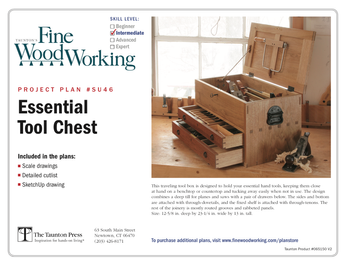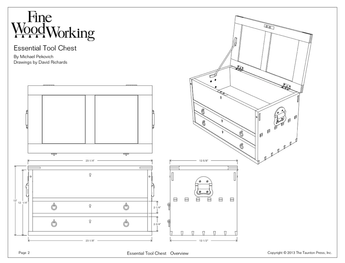Hello,
I recently purchased my first Japanese smoothing plane from Japan Woodworker. After letting the wood body adjust to my shop for 2 weeks (with the blade lightly in place) I polished up the blade, checked the sole and started tapping in the blade as described by the various books I have. When I was close to the depth I thought was right I lightly tapped in the chip breaker. When I ran my first test I discovered the blade was set too far. I tried to back it out by striking the back of the plane body, but the thing won’t budge. I have tried tapping around on different parts of the blade, pulling the blade and knocking the blade back out with a block of hardwood, but nothing seems to work. Can someone please give me some advice before I do something drastic?
Here is the plane I purchased:
70mm 40 Degree Smoothing Plane -Sakura Hiromasa
Any help is greatly appreciated!
Brian















Replies
Here's a link to a Japanese tool forum they have all kinds of information on Japanese planes and other tools. http://www.japanesetools.com/phpBB3/index.php?sid=93706a6d0f084552deffc1132382677a
Also check out http://www.daikudojo.org/index.html
If your in the San Francisco Bay Area there is a class on using Japanese hand tools at Merit College. Jay Van Arsdale teaches it on Saturdays and it would help you a lot. Good luck with your plane
Troy
Thanks for the feedback. I have been trying to post to the Japanese woodworking forum for the last two days, but seem to be having trouble with my account. I have found a lot of info on both the sites you mentioned for adjusting the plane body if the blade fit is not perfect, but nothing about how to correct for the knuckle-head factor if you just hit the blade home regardless of fit. Sure wish I wouldn't have gotten overexcited!
Hello Brian,
Let me say good job on being open to tools other than the norm. What are you using to tap on the plane body with ?
A hammer I assume but if you are using a shot filled dead blow or a rubber mallet etc. this could be your problem. Try a steel hammer.
You might even consider putting the plane in a drier environment or a damper one. Or both to get the grip on the blade to loosen up.
I am betting on a largish, steel, plane adjusting hammer and several solid whamps.
You are holding the plane in your hand when you tap it right ? Not in a vise or holding it on the bench.
Also on some of the finish planes the last bit of the opening needs to be hand fitted with a chisel on the corners/ends of the mouth opening. Maybe it is stuck in the wood there and once you get it out you may need to use the pencil lead on the metal trick to see where it is touching and not touching and fit it for proper contact and chip clearance. Hopefully your books explain this.
Here is another thought that just occurred to me. Some of the old plane users put the whole wood block in a bucket of oil and let it absorb until saturated. I think modern users have given up on all that but may be worth putting a sloppy amount of camellia oil all around where the blade sits and let it draw into the wood for a few hours then whamp again.
Probably a last resort.
I have not had this stiction problem but can imagine it is most frustrating.
You could also call the Japan Woodworker. Even on Saturdays I think there is a guy there that answers tech questions.
He turned out to be of limited value to me. He promised to handle something "personally", to use his phrase, as a go between between the owner and myself for availability of a high end plane. Then he just refused to continue the conversation with no explanation. Very rude and confusing. I simply wanted a yes or no answer on the availability of a finish plane that they had offered a few years back ($500 plus price tag not like I am wasting his time ). Then no answer, no response just an attitude of go to Hades we don't care about you. Isn't like I didn't already have a history of buying the best they had to offer.
Not impressed. To their credit I have had exceptionally good customer care from their other employes and the owner's wife. There was an error on a chisel, misshelved / misslabeled, and she got it all straightened out with a letter of apology. Nicely done ! Thank You !
The owner and the tech guy are special though.
roc
Give me six hours to chop down a tree and I will spend the first four sharpening the axe. Abraham Lincoln ( 54° shaves )
Edited 12/11/2009 11:36 pm by roc
This happened to me with a 22" plane I bought from a flea market.
My solution was to grip the blade in a vice add pull, wiggle and whack until it loosened. You might not want to do this with an expensive plane.
That's pretty much what LV says for their Asian molding planes: hold the blade in a vice and tap the heel of the plane with a hammer.
Jim
Put it in the freezer for an hour then try to get the blade out. The blade should contract more than the wood and out it comes.
Am I the only one who sees a bit of humor in giving a woodworking plane a wedgie? Probably.
I have a Scandinavian plane that "adjusts" in the same manner. Steel hammer, light-medium weight, and some practice got me going.
You might need one of those sexy Japanese square hammers for your plane, though. ;-)
Do you still have the sub blade in the dai? Did you fit the blade to the dai prior to using? You may have to clamp the blade in a wood vise and gently use a block of wood and hammer to drive the dai away from the blade. Also if your sub blade is still in place remove the sub blade. You may need to remove the pin to do so if it is wedged tight.
You should be approved soon to use the Japanese tool forum. See you there.
Timberwerks Studio Blog
Timberwerks On Twitter
Thanks everyone, the freezer trick with some good taps did the job. I really appreciate the feedback. Any good tips for setting it up correctly this time?
Edited 12/12/2009 11:11 pm ET by FlatheadWoodWorks
Yes, this DVD http://www.japanesetools.com/index.php?main_page=product_info&cPath=90_92&products_id=5528 it is money well spent. I converted to kanna about 5 years ago, I sold my Western planes to buy more kanna.Timberwerks Studio Blog
Timberwerks On Twitter
I've got that on my wish list. I recently had some unexpected maintenance issues with our house, so the tool budget isn't what it once was. However, if the wife was looking for a great Christmas present....
A few of my kanna.
Timberwerks Studio Blog
Timberwerks On Twitter
Questions for Japanese tool experts:
What is the traditional Japanese tool for cutting tight curves, fretwork, inlays, etc.?
What kind of carving tools do/did the Japanese use for relief carving? Is there a number system for these (like the "Sheffield" system)? How are they identified and sold?
Thanks.
This forum post is now archived. Commenting has been disabled